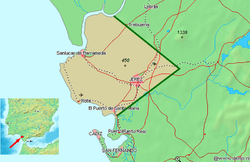Manzanilla

Manzanilla is a dry, fortified white wine that belongs to the group of sherries , in the narrower sense the group of finos. It is pressed exclusively in Sanlúcar de Barrameda in southwestern Spain from musts of the Palomino -Fino grape.
Manufacturing
Despite many similarities to the Fino sherry from Jerez , the Manzanilla differs in some points. The grapes are still somewhat unripe, harvested on average about a week before they are fully ripe and processed immediately. The early harvest time gives musts a rather pronounced acidity. For high-quality manzanillas, only the first-run musts are used ( vino de yema ), i.e. those that are obtained with practically no or little pressure. The musts that follow, obtained under greater pressure, are also used for the production of brandy . The larger bodegas therefore often also produce brandy. After the first stormy fermentation, the must is fortified with alcohol to about 15.5 percent by volume. This will kill the wild yeast and stop the first fermentation.
This is followed by a calm fermentation with wine yeast ( Saccharomyces ellipsoideus ), which lasts about 10 weeks. In large companies, fermentation takes place in huge steel tanks. Some smaller and respecting tradition Bodegas vinify but still in new, from the wood of American white oak ( Quercus alba geküferten) barrels. The barrels are also prepared for the later storage of the wines.
The fermented young wines are in the 600-liter barrels Sherry, the Botas , transferred and stored. The botas are not completely filled, usually only 5 sixths, sometimes only 4 fifths. Very soon after decanting, a veil of flor yeast ( velo de flor ) forms on the surface , which prevents oxidation during storage.
Storage and maturation
Like finos, manzanillas ripen in the so-called solera-críadera system. Attempts to make vintage manzanillas have not yielded satisfactory results and have largely been abandoned. In this system, the wines are stored in age groups (Críadera) one above the other. The oldest wine is in the barrels on the bottom ( Solera is derived from suelo = soil). Bottles are filled from the lowest, the Solera barrels, the filled amount is refilled from the críadera above, which in turn receive the missing amount from the above. The number of críaderas varies; there are always three críaderas above the solera, sometimes up to twenty.
Good manzanillas indicate the year in which the solera was launched. Solera 1967 does not mean that this wine was made in 1967, as this Solera has always been topped up with younger wines.
character
The Manzanilla is a straw-yellow, mostly dry, sometimes acidic, piquant white fortified wine that is mainly drunk as an aperitif . Successful manzanillas are characterized by a light salty aroma, interesting wood tones and, in contrast to the Fino from Jerez, by a refreshing acidity. The alcohol level is 15.5 percent by volume . It should be drunk very cold (5–7 ° C). Once opened, bottles should not be kept for longer than a day.
Manzanillas that have been stored for a very long time are occasionally offered as manzanilla pasada, but mostly processed into an amontillado . Due to the no longer completely existing layer of pile, these wines are somewhat oxidized, i.e. darker and stronger in the bouquet . Such wines often develop an almond aroma.
literature
- Roger Voss: Pocket Guide to Fortified and Dessert Wines. Mitchel Beazley, 1989, ISBN 0-85533-698-6 .
- F. Paul Pacult: Kindred Spirits: The Spirit Journal Guide to the World's Distilled Spirits and Fortified Wines . Hyperion Books, 1997, ISBN 0-7868-8172-0 .
- Stephen Brook: Liquid Gold: Dessert Wines of the World. Constable, 1987, ISBN 0-09-466920-1 .
- Horst Dippel (ed.): The wine lexicon . Fischer-Taschenbuch-Verlag, Frankfurt am Main 1989, ISBN 3-596-24501-X .